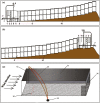Wing loading, not terminal velocity, is the best parameter to predict capacity of diaspores for secondary wind dispersal
- PMID: 32242240
- PMCID: PMC7475251
- DOI: 10.1093/jxb/eraa170
Wing loading, not terminal velocity, is the best parameter to predict capacity of diaspores for secondary wind dispersal
Abstract
Lift-off velocity may be the most useful surrogate to measure the secondary dispersal capacity of diaspores. However, the most important diaspore attribute determining diaspore lift-off velocity is unclear. Furthermore, it is not known whether terminal velocity used to characterize the primary dispersal capacity of diaspores can also be used to predict their secondary wind dispersal capacity. Here, we investigate how diaspore attributes are related to lift-off velocity. Thirty-six species with diaspores differing in mass, shape index, projected area, wing loading, and terminal velocity were used in a wind tunnel to determine the relationship between diaspore attributes and lift-off velocity. We found that diaspore attributes largely explained the variation in lift-off velocity, and wing loading, not terminal velocity, was the best parameter for predicting lift-off velocity of diaspores during secondary wind dispersal. The relative importance of diaspore attributes in determining lift-off velocity was modified by both upwind and downwind slope directions and type of diaspore appendage. These findings allow us to predict diaspore dispersal behaviors using readily available diaspore functional attributes, and they indicate that wing loading is the best proxy for estimating the capacity for secondary dispersal by wind.
Keywords: Appendage type; diaspore mass; diaspore shape index; downwind slope; terminal velocity; upwind slope; wind tunnel; wing loading.
© The Author(s) 2020. Published by Oxford University Press on behalf of the Society for Experimental Biology. All rights reserved. For permissions, please email: journals.permissions@oup.com.
Figures


Similar articles
-
Variation in morphological traits affects dispersal and seedling emergence in dispersive diaspores of Geropogon hybridus.Am J Bot. 2020 Mar;107(3):436-444. doi: 10.1002/ajb2.1430. Epub 2020 Feb 18. Am J Bot. 2020. PMID: 32072626 Free PMC article.
-
Mass allocation, moisture content, and dispersal capacity of wind-dispersed tropical diaspores.New Phytol. 1988 Mar;108(3):357-368. doi: 10.1111/j.1469-8137.1988.tb04174.x. New Phytol. 1988. PMID: 33873935
-
Plant canopy may promote seed dispersal by wind.Sci Rep. 2022 Jan 7;12(1):63. doi: 10.1038/s41598-021-03402-9. Sci Rep. 2022. PMID: 34996929 Free PMC article.
-
Intraspecific variation in seed dispersal of a Neotropical tree and its relationship to fruit and tree traits.Ecol Evol. 2016 Jan 25;6(4):1128-42. doi: 10.1002/ece3.1905. eCollection 2016 Feb. Ecol Evol. 2016. PMID: 26839686 Free PMC article.
-
Secondary dispersal mechanisms of winged seeds: a review.Biol Rev Camb Philos Soc. 2019 Oct;94(5):1830-1838. doi: 10.1111/brv.12537. Epub 2019 Jun 19. Biol Rev Camb Philos Soc. 2019. PMID: 31215745 Review.
Cited by
-
Intraspecific Variation of Samara Dispersal Traits in the Endangered Tropical Tree Hopea hainanensis (Dipterocarpaceae).Front Plant Sci. 2020 Nov 13;11:599764. doi: 10.3389/fpls.2020.599764. eCollection 2020. Front Plant Sci. 2020. PMID: 33281856 Free PMC article.
-
Inflated Ovary May Increase the Dispersal Ability of Three Species in the Cold Deserts of Central Asia.Plants (Basel). 2023 May 10;12(10):1950. doi: 10.3390/plants12101950. Plants (Basel). 2023. PMID: 37653867 Free PMC article.
References
-
- Andersen MC. 1992. An analysis of variability in seed settling velocities of several wind-dispersed asteraceae. American Journal of Botany 79, 1087–1091. - PubMed
-
- Andersen MC. 1993. Diaspore morphology and seed dispersal in several wind-dispersed asteraceae. American Journal of Botany 80, 487–492. - PubMed
-
- Arnold GP, Weihs D. 1978. The hydrodynamics of rheotaxis in the plaice (Pleuronectes platessa L.). Journal of Experimental Biology 75, 147–169.
-
- Augspurger CK. 1986. Morphology and dispersal potential of wind-dispersed diaspores of neotropical trees. American Journal of Botany 73, 353–363.
-
- Burrows M. 1973. The morphology of an elevator and a depressor motoneuron of the hindwing of a locust. Journal of Comparative Physiology 83, 165–178.
Publication types
MeSH terms
LinkOut - more resources
Full Text Sources

